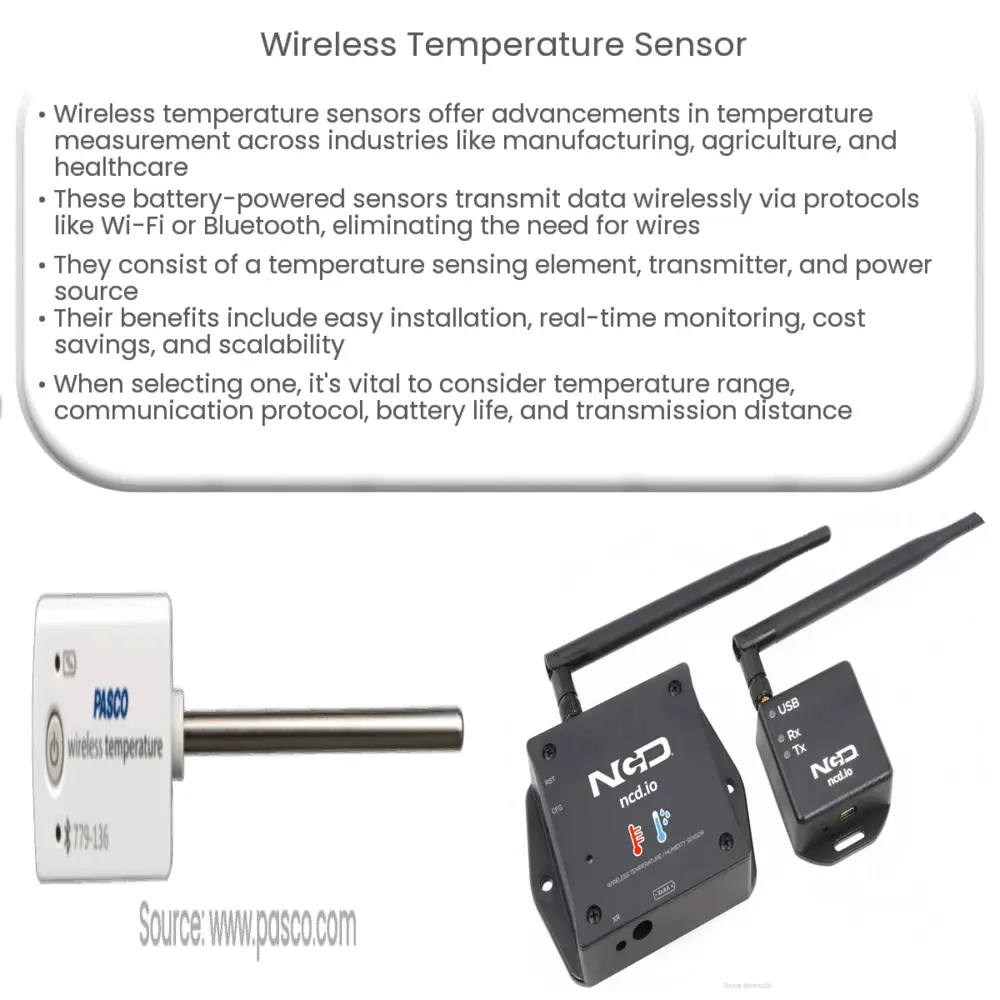Explore the functionalities, components, applications, benefits, and selection criteria of wireless temperature sensors in our comprehensive guide.

Understanding Wireless Temperature Sensors
Wireless temperature sensors are a significant technological advancement in the realm of temperature measurement and control. These tools play an essential role in various industries, including manufacturing, agriculture, healthcare, and many more. Let’s take a closer look at what wireless temperature sensors are and how they operate.
What are Wireless Temperature Sensors?
Wireless temperature sensors are compact, battery-powered devices that measure temperature data. Unlike their wired counterparts, these sensors do not require physical connections to transmit their readings. Instead, they use wireless communication protocols like Wi-Fi, Bluetooth, Zigbee, or Z-Wave to relay information to a base station or directly to an internet-connected device.
Components of a Wireless Temperature Sensor
A typical wireless temperature sensor consists of three main components:
- Temperature sensing element: This is the part of the sensor that directly interacts with the environment to measure the temperature. It could be a thermistor, resistance temperature detector (RTD), or a thermocouple, among others.
- Transmitter: This component converts the temperature readings into a digital signal and transmits it to a receiver via a wireless communication protocol.
- Power source: Wireless temperature sensors are usually battery-powered, although some models can be powered by solar energy or other sources.
Working Principle of Wireless Temperature Sensors
The wireless temperature sensor’s working principle is relatively straightforward. The temperature sensing element detects changes in environmental temperature and converts these changes into an electrical signal. This signal is then processed and converted into a digital format by the transmitter. Finally, the transmitter sends this digital data wirelessly to a receiver, which can be a computer, a smartphone, or a dedicated device. This entire process occurs in real-time, enabling continuous temperature monitoring and control.
Applications of Wireless Temperature Sensors
Wireless temperature sensors find numerous applications due to their flexibility, ease of installation, and real-time monitoring capabilities. Here are a few key areas where they are commonly used:
- They are widely used in the manufacturing sector for quality control and to ensure optimal operating conditions.
- In the healthcare sector, they help maintain the required temperature in storage facilities for vaccines, medicines, and other temperature-sensitive items.
- They are invaluable in the agricultural sector, where they help monitor soil and air temperature to aid in effective crop management.
Advantages of Wireless Temperature Sensors
Wireless temperature sensors come with a host of advantages over traditional wired sensors, making them an increasingly popular choice in various industries. Here are a few notable benefits:
- Easy Installation and Maintenance: Wireless temperature sensors are easy to install, with no complex wiring required. This feature also makes them easy to relocate if necessary. Maintenance is generally straightforward, usually involving only battery replacement.
- Real-time Monitoring: These sensors allow for continuous, real-time monitoring of temperature changes, enabling instant alerts and rapid response to any significant fluctuations.
- Reduced Cost: The absence of wiring infrastructure not only simplifies installation but also significantly reduces the cost associated with installation, maintenance, and potential wire damage.
- Scalability: It’s easy to increase the network of sensors in a system, making wireless temperature sensors a scalable solution suitable for both small and large applications.
Considerations when Choosing Wireless Temperature Sensors
When deciding on a wireless temperature sensor, it’s crucial to consider a few factors:
- The range of temperature that the sensor can accurately measure.
- The wireless communication protocol it uses and its compatibility with your existing systems.
- The sensor’s battery life, as it directly impacts maintenance cycles.
- The sensor’s range or the maximum distance it can transmit data without signal loss.
By considering these factors, you can choose a wireless temperature sensor that best suits your specific needs and circumstances.
Conclusion
In conclusion, wireless temperature sensors are powerful tools that provide valuable temperature data in various settings. Their ease of installation, real-time monitoring capabilities, cost-effectiveness, and scalability make them an ideal choice for many industries. However, while choosing a wireless temperature sensor, it is important to consider its temperature range, communication protocol, battery life, and transmission range. With the right choice, these sensors can significantly enhance your ability to monitor and control environmental temperature conditions, thereby improving efficiency and productivity in your operations.

